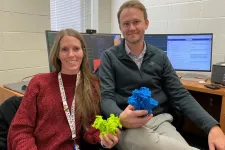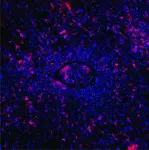(Press-News.org) (February 2, 2024) The National Association of Epilepsy Centers (NAEC) has developed updated guidelines that outline the comprehensive services and resources epilepsy centers should provide to improve quality of care for people whose epilepsy is not well-controlled.
An Executive Summary of the 2023 Guidelines for Specialized Epilepsy Centers: Report of the National Association of Epilepsy Centers Guideline Panel was published online on February 2, 2024, in Neurology®, the medical journal of the American Academy of Neurology. The complete NAEC guidelines are published as an eAppendix on the journal’s website.
Epilepsy is one of the most common chronic neurologic conditions worldwide, with an estimated prevalence of 3.4 million in the United States. The condition, which causes recurring seizures, can be debilitating and life-threatening. It is associated with decreased quality of life and far-reaching socioeconomic implications.
About 30 percent of people with epilepsy have seizures that do not respond to medication. Uncontrolled seizures affect all aspects of life, such as the ability to learn or live independently. For these individuals, and those experiencing unacceptable side effects from antiseizure medications, epilepsy centers can provide a more personalized level of care that improves a patient’s total well-being.
“The field has changed significantly since NAEC issued its last guideline update over 10 years ago,” said Fred Lado, MD, PhD, NAEC president, guideline panel co-chair, and regional director of epilepsy and professor of neurology at Zucker School of Medicine at Hofstra/Northwell in Hempstead, New York. “In addition to advances in medicine, there has been a shift toward addressing overall well-being beyond seizure management. This includes care for comorbid conditions like anxiety and depression, enhanced communication between the patient and care team, and addressing health disparities in the epilepsy community. Expanded guidelines are also sorely needed to help centers and hospitals obtain the resources to provide this level of comprehensive care.”
The 2023 guidelines include 52 recommendations that span the range of services that should be part of high-quality epilepsy centers, including inpatient evaluation, therapeutic options, and outpatient chronic disease management. The guidelines recognize the importance of multi-disciplinary care teams in coordinating the effort of different specialists working together to diagnose and treat patients.
For the first time, the guidelines recommend centers should
offer genetic testing and counseling.
provide more education and communication for patients.
give greater attention to special needs populations.
employ a care coordinator who organizes and facilitates multidisciplinary care.
provide mental health screening (anxiety, depression, and learning difficulties are much more common in people with epilepsy than the general population).
address health disparities and inequities among the epilepsy patient population.
The recommendations were informed by an evidence review and reflect the consensus of a multidisciplinary panel of 41 stakeholders with diverse expertise, including patient and caregiver representatives, EEG technologists, nurse practitioners, social workers, neurosurgeons, neuroradiologists, and others who support epilepsy center care.
“All recommendations quickly reached consensus despite there being such a diverse panel of stakeholders, which emphasizes that the recommendations reflect the important elements of healthcare services that should be in place for an epilepsy center to provide the highest quality of care,” said Susan Arnold, MD, guideline panel co-chair and a pediatric epileptologist at Yale University School of Medicine.
“We want to improve the quality of care across the board for people with epilepsy in the United States. NAEC has accredited centers that provide very high quality of care, but each center has different strengths. By working together with these consensus guidelines, we can elevate the standards of quality care for all centers,” said Dr. Arnold.
NAEC issued its first epilepsy center guidelines in 1990 and has developed updated guidelines every decade since. The 2023 guidelines, solely funded by NAEC, are the first to be established on an evidence-informed, consensus-based process. NAEC contracted with EBQ Consulting to develop evidence-based and trustworthy consensus-based statements that conform with established international standards. In the absence of strong evidence, recommendations were guided by consensus from the panels of experts and highlight areas of need for additional research.
“When patients feel their treatment options are limited, they don’t have to accept ‘good enough.’ Epilepsy centers offer hope,” said Dr. Arnold. “But epilepsy centers will need the resources to provide this comprehensive level of care. We hope the guidelines will help increase health insurer and institutional support and recognition of these recommendations.”
As additional research becomes available, practice standards become established, and clinical knowledge grows, NAEC will continue to update the guidelines. Over time, these guidelines will inform NAEC’s accreditation standards for epilepsy centers.
###
NAEC is a non-profit association with a membership of more than 260 specialized epilepsy centers in the United States. NAEC published its first iteration of its Guidelines for Essential Services, Personnel, and Facilities in Specialized Epilepsy Centers in 1990. The Association continues its work to develop standards of care and promote their adoption by epilepsy centers through its accreditation program. NAEC pursues an active agenda, educating public and private insurers, policymakers, and government officials about the complexities of and need for patient access to specialized epilepsy services. NAEC was founded in 1987 by physicians committed to setting a national agenda for quality epilepsy care. https://www.naec-epilepsy.org.
END
With a $300,000 grant, the Welch Foundation is supporting University of Texas at Arlington research into why some types of Mycobacterium tuberculosis (Mtb), the bacteria that causes the lung disease tuberculosis (TB), do not respond to treatments.
Since its founding in 1954, the Houston-based Welch Foundation has contributed to the advancement of chemistry through research grants, departmental programs, endowed chairs and other special projects in Texas.
“As one of the nation’s largest private funding sources for chemical research, it is our job ...
Many people are familiar with facial recognition systems that unlock smartphones and game systems or allow access to our bank accounts online. But the current technology can require boxy projectors and lenses. Now, researchers report in ACS’ Nano Letters a sleeker 3D surface imaging system with flatter, simplified optics. In proof-of-concept demonstrations, the new system recognized the face of Michelangelo’s David just as well as an existing smartphone system.
3D surface imaging is a common tool used in smartphone facial recognition, as well as in computer vision and autonomous driving. These systems typically consist of a dot projector that contains multiple components: ...
Many complex systems, from microbial communities to mussel beds to drylands, display striking self-organized clusters. According to theoretical models, these groupings play an important role in how an ecosystem works and its ability to respond to environmental changes. A new paper in PNAS focused on the spatial patterns found in drylands offers important empirical evidence validating the models.
Drylands make up 40 percent of the Earth’s landmass and are places where water is the limiting resource for life. They often display a characteristic ...
DURHAM, N.C. – As the HIV virus glides up outside a human cell to dock and possibly inject its deadly cargo of genetic code, there’s a spectacularly brief moment in which a tiny piece of its surface snaps open to begin the process of infection.
Seeing that structure snap open and shut in mere millionths of a second is giving Duke Human Vaccine Institute (DHVI) investigators a new handle on the surface of the virus that could lead to broadly neutralizing antibodies for an AIDS vaccine. Their findings appear Feb. 2 in Science Advances.
Being able to attach an antibody specifically to ...
Some hereditary genetic defects cause an exaggerated immune response that can be fatal. Using the CRISPR-Cas9 gene-editing tool, such defects can be corrected, thus normalizing the immune response, as researchers led by Klaus Rajewsky from the Max Delbrück Center now report in “Science Immunology.”
Familial hemophagocytic lymphohistiocytosis (FHL) is a rare disease of the immune system that usually occurs in infants and young children under the age of 18 months. The condition is severe and has a high mortality rate. It is caused by various gene mutations that prevent cytotoxic T cells from functioning normally. These ...
BIRMINGHAM, Ala. – Cigarette smoke exposure is associated with the development and severity of chronic obstructive pulmonary disease, or COPD, which is the third leading cause of death worldwide.
Cigarette smoke contains 2 to 3 micrograms of cadmium, a highly toxic metal and environmental pollutant, per cigarette. Burning tobacco releases cadmium oxide that can be adsorbed onto microparticles in smoke that travel deep into the lungs. Furthermore, the body is not able to remove cadmium, which accumulates in longtime smokers.
In ...
First-of-its-kind research on cryptocurrency finds that the most regulated coins create the most efficient markets.
That crypto regulation, often provided by cryptocurrency exchanges like Binance, can also help protect investors by providing reliable, public information.
“Both small and institutional investors should know, if they invest in coins without any regulation, they may suffer from price manipulation or a severe lack of insider information,” said Liangfei Qiu, a University of Florida professor of business and one of the authors of the new study.
“Instead, they may want to invest in coins listed with platforms ...
The ancient astronomer Nicolaus Copernicus was the first scientist to document the theory that the sun is the center of the universe in his book, De Revolutionibus Orbium Coelestium (On the Revolutions of the Heavenly Spheres). That first edition book, along with a delicate manuscript from astronomer Johannes de Sacrobosco, that is contrary to Copernicus’ groundbreaking theory, has now found a permanent home at Rochester Institute of Technology.
The texts were donated to RIT’s Cary Graphic Arts Collection, one of the world’s premier libraries on graphic communication history and practices. The donor is Irene ...
The genetic material, in the form of DNA, contains the information that is crucial for the correct functioning of every human and animal cell. From this information repository, RNA, an intermediate between DNA and protein, the functional unit of the cell, is generated. During this process, the genetic information must be tailored for specific cell functions. Information that is not needed (introns) is cut out of the RNA and the important components for proteins (exons) are preserved. A team of researchers led by Professor Dr Mirka Uhlirova at the University of Cologne’s CECAD Cluster of ...
RICHLAND, Wash.—Doctors have nearly a dozen new targeted drugs to treat patients with acute myeloid leukemia, or AML, yet three of four patients still die within five years. Some patients succumb within just a month or two, despite the battery of drugs used to treat the aggressive blood disease, where blood cells don’t develop properly.
A new study draws on a field of science known as proteogenomics to try to improve the outlook. In a paper published Jan. 16 in Cell Reports Medicine, scientists report new ...





